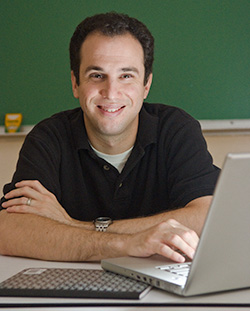Filed Under > TC People
The Education Guy
Matthew Pittinsky has founded a billion-dollar company, but his heart is in the classroom.
Teachers College is that rare atmosphere where someone can be both remarkable and typical, and Matthew Pittinsky fits into that mold—Pittinsky’s passionate devotion to education and excitement about the potential research has to improve children’s lives has remained undiminished as he toils at his dissertation for the Sociology in Education program and experiences the joys and sleep deprivation of being a new father. Yet few other TC students have to leave class to give a speech in Chicago or for a live interview with the Washington Post, and fewer still have seen a company they founded in their twenties grow in value to more than a billion dollars.
Pittinsky is the co-founder of Blackboard, Inc., a company that provides software for teachers and students to organize their coursework online that is used by more than 12 million people at more than 2,000 colleges, schools and companies.
He founded the company in 1997 and served as its Chairman or, as he puts it, “the Education Guy.” Since he had been in the classroom as a teacher and through education schools, with an Ed.M. from Harvard and working toward a doctorate at TC, he had an on-the-ground perspective of education that helped the company stand out in a market thick with competitors. For example, he says, “I realized that technology isn’t a universal solution. The universal goals of education are so complex that Blackboard presents itself not as a solution, just as a means to an end.” The company worked to make its product simple and clear to use, so that even professors without technological savvy could adapt to it. Also important, Pittinsky says, was that he realized how decentralized the education system is. Instead of contacting institutions and trying to force a top-down approach, Blackboard made in-roads by contacting teachers directly, and letting them develop uses in their own ways.
With all Blackboard’s early success, then, why has Pittinsky stepped away from executive control of the company to focus on a dissertation? “Education is in my blood,” he says. His mother was a teacher, his father a school board president and university administrator. The “Education Guy” wants to live up to his name and become a professor.
Still, he’s not turning his back on his experiences at Blackboard. “The skills I developed while managing a large organization affect the sort of researcher that I am.” he says. “I’m an entrepreneur at heart. I look at a problem and say ‘there should be a product for that, and smart people can figure out how best to use it.’”
To that end, he’s been working with TC professors Hank Levin, Gary Natriello and Aaron Pallas at TC’s EdLab—a creative team within TC’s Gottesman Libraries—on projects like the Networked Education Database, a massive database of classroom data. “We want to build on the fact that most schools have informational systems that store data of interest, so we’ve been beginning to build a repository of networked school information systems connected to a central repository.” Once the collection is automated, it will include ways to use Web surveys and a highly scalable data source available at minimal cost. EdLab ran a pilot of the project with 10 teachers this past year, and Pittinsky is excited about the results.
Pittinsky knows that technology isn’t a panacea, but he still feels there is a great amount of untapped potential in the classroom for technology to be used in the right way. “There are three great technologies: database, the network and multimedia. In a database, you have the ability to make visible patterns and relationships that we couldn’t imagine in a physical classroom—no one remembers who raised their hand and how many times. With networks we can learn about South Africa from South African students and teachers. Parents can get involved in what’s going on in a classroom, and we can create a more engaging activity. With multimedia we can do things like dissect frogs from the inside out and learn in a more visual way.” It takes imaginative users to give technology its power, he says. “Simply licensing a database, what does that do for education?”
How has he found the time to pursue all his interests? He shrugs. “I always thought I had the easiest set-up, compared to the students here who teach classes. They have to get up at 5 a.m., teach, maybe grab dinner before taking classes in the evening and return home to grade papers. I’m my own boss.”
Published Tuesday, Sep. 4, 2007
